6. Collecting All Future Screen Clippings in One Place
If you want to make the process of collecting
multiple screen clippings a complete no-brainer, consider creating a
special section in your main notebook that you’ll use as the automatic
target destination for all of your future screen clippings.
To collect multiple screen clippings in one place, follow these steps:
1. | In your notebook, create a new section and name it “My Screen Clippings” (or a similarly meaningful description).
|
2. | Bring
into view what you want to capture, right-click the small OneNote icon
in the notification area (or hold down the Windows key and press S), and
then click Create Screen Clipping.
|
3. | When the screen dims, drag a selection with the mouse to create your screen clipping.
|
4. | In
the Select Location in OneNote dialog box, find the “My Screen
Clipping” section you created in step 1 and click it once to select it.
|
5. | Just
underneath the list of notebooks and sections, select the check box
labeled Don’t Ask Me Again and Always Do the Following (see Figure 7).

|
6. | Click Send to Selected Location.
|
OneNote creates a new page for your screen clipping
in this section. In addition, because you checked the box that told it
to stop asking for a destination the next time, all of your future
screen clippings that you initiate from the OneNote icon in the Windows
taskbar notification area or with the Windows key + S keyboard shortcut
will be sent to this location automatically without you having to make a
decision or selection each time you take a screen clipping.
This is the fastest way to take a bunch of screen
clippings for collecting information and research and then review the
“My Screen Clippings” section in your notebook later, where you can
consolidate, delete, or move screen clippings to where you ultimately
want them.
If
you later decide you want the quick filing feature to prompt you again
about where you want each screen clipping to be saved, you can restore
the appearance of the Select Location in OneNote dialog box. Click the
File tab and then click Options. In the OneNote Options dialog box that
opens, click the Send to OneNote category in the list on the left, and
then change the Screen clippings option to Always ask where to send.
Click OK to save your preference.
This procedure will restore the quick filing
dialog box after each screen clipping that you initiate with the
OneNote icon in the Windows taskbar notification area or with the
Windows key + S keyboard shortcut.